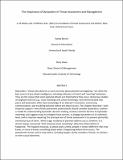The Importance of Bystanders in Threat Assessment and Management
Author(s)
Borum, Randy; Rowe, Mary
DownloadBook Chapter (518.7Kb)
Metadata
Show full item recordAbstract
Bystanders—those who observe or come to know about potential wrongdoing—are often the best source of pre-attack intelligence, including indicators of intent and “warning” behaviors. They are the reason that some planned attacks are foiled before they occur. Numerous studies of targeted violence (e.g., mass shootings and school shootings), have demonstrated that peers and bystanders often have knowledge of an attacker’s intentions, concerning communication, and troubling behavior before the attack occurs. This chapter describes—with
empirical support—why threat assessment professionals should consider bystanders; outlines a model for understanding bystander decision making; reviews common barriers to bystander reporting; and suggests ways to mitigate those barriers, to engage bystanders at an individual level, and to improve reporting. The principal aim of threat assessment is to prevent (primarily) intentional acts of harm. When tragic incidents of planned violence occur, however, it is almost always uncovered “that someone knew something” about the attack before it happened. This happens because, as attack plans unfold, people in several different roles may know, or come to know, something about what is happening before harm occurs. The perpetrators know, and so may others, including targets, family members, friends, co-workers, or even casual observers.
Date issued
2021Publisher
Oxford University Press
Citation
Randy Borum and Mary Rowe, “The Importance of Bystanders in Threat Assessment and Management,” chapter 24 in The International Handbook of Threat Assessment, 2nd ed., ed. J. Reid Meloy and Jens Hoffmann (New York: Oxford University Press, 2021).
Keywords
bystanders, threat assessment, violence prevention